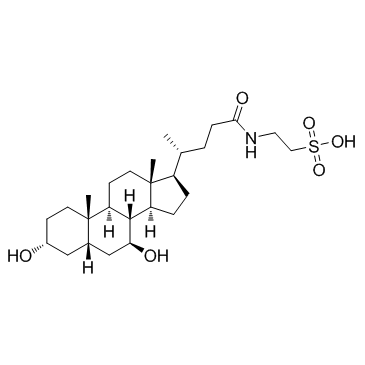Tauroursodeoxycholic acid

Tauroursodeoxycholic acid structure
|
Common Name | Tauroursodeoxycholic acid | ||
|---|---|---|---|---|
| CAS Number | 14605-22-2 | Molecular Weight | 499.70 | |
| Density | 1.2±0.1 g/cm3 | Boiling Point | 496.4ºC at 760mmHg | |
| Molecular Formula | C26H45NO6S | Melting Point | 173-175°C | |
| MSDS | USA | Flash Point | 214.2ºC | |
|
Lysosomes and unfolded protein response, determinants of differential resistance of melanoma cells to vinca alkaloids.
Fundam. Clin. Pharmacol. 29(2) , 164-77, (2015) On account of its strong ability to become chemoresistant after a primary response to drugs, malignant melanoma (MM) remains a therapeutic challenge. This study focuses on acquired resistance to vinca alkaloids (VAs) using VA-resistant MM cell lines (CAL1R-VC... |
|
|
Regulation of host weight gain and lipid metabolism by bacterial bile acid modification in the gut.
Proc. Natl. Acad. Sci. U. S. A. 111(20) , 7421-6, (2014) Alterations in the gastrointestinal microbiota have been implicated in obesity in mice and humans, but the key microbial functions influencing host energy metabolism and adiposity remain to be determined. Despite an increased understanding of the genetic cont... |
|
|
Tauroursodeoxycholic acid inhibits experimental colitis by preventing early intestinal epithelial cell death.
Lab. Invest. 94(12) , 1419-30, (2014) Ulcerative colitis (UC) is characterized by increased epithelial cell death and subsequent breakdown of the intestinal epithelial barrier, which perpetuates chronic intestinal inflammation. Since fecal bile acid dysmetabolism is associated with UC and taurour... |
|
|
Chemical chaperones reduce ionizing radiation-induced endoplasmic reticulum stress and cell death in IEC-6 cells.
Biochem. Biophys. Res. Commun. 450(2) , 1005-9, (2014) Radiotherapy, which is one of the most effective approaches to the treatment of various cancers, plays an important role in malignant cell eradication in the pelvic area and abdomen. However, it also generates some degree of intestinal injury. Apoptosis in th... |
|
|
Endoplasmic reticulum stress participates in aortic valve calcification in hypercholesterolemic animals.
Arterioscler. Thromb. Vasc. Biol. 33(10) , 2345-54, (2013) Aortic valve (AV) calcification occurs via a pathophysiological process that includes lipoprotein deposition, inflammation, and osteoblastic differentiation of valvular interstitial cells. Here, we investigated the association between endoplasmic reticulum (E... |
|
|
Progressive stages of mitochondrial destruction caused by cell toxic bile salts.
Biochim. Biophys. Acta 1828(9) , 2121-33, (2013) The cell-toxic bile salt glycochenodeoxycholic acid (GCDCA) and taurochenodeoxycholic acid (TCDCA) are responsible for hepatocyte demise in cholestatic liver diseases, while tauroursodeoxycholic acid (TUDCA) is regarded hepatoprotective. We demonstrate the di... |
|
|
Altered unfolded protein response is implicated in the age-related exacerbation of proteinuria-induced proximal tubular cell damage.
Am. J. Pathol. 183(3) , 774-85, (2013) Aging is a dominant risk factor for end-stage renal disease. We analyzed the mechanism involved in age-related exacerbation of proteinuria-induced proximal tubular cell (PTC) damage by focusing on endoplasmic reticulum-related unfolded protein response (UPR).... |
|
|
Unsaturated FAs prevent palmitate-induced LOX-1 induction via inhibition of ER stress in macrophages.
J. Lipid Res. 52 , 299, (2011) Palmitic acid (PA) upregulates oxidized LDL receptor-1 (LOX-1), a scavenger receptor responsible for uptake of oxidized LDL (oxLDL), and enhances oxLDL uptake in macrophages. However, the precise underlying mechanism remains to be elucidated. PA is known to i... |
|
|
Improvement of estradiol-17 beta-D-glucuronide-induced cholestasis by sodium tauroursodeoxycholate therapy in rats.
Scand. J. Gastroenterol. 32 , 947, (1997) Estradiol-17 beta-D-glucuronide (E-17G), a metabolite of natural estrogen, is well known to cause intrahepatic cholestasis in humans. We therefore investigated the effect of sodium tauroursodeoxycholate (T-UDCA), on E-17G-induced cholestasis in female rats.Fo... |
|
|
TUDCA, a bile acid, attenuates amyloid precursor protein processing and amyloid-β deposition in APP/PS1 mice.
Mol. Neurobiol. 3rd ed., 45 , 440-454, (2012) Alzheimer's disease (AD) is a neurodegenerative disorder characterized by accumulation of amyloid-β (Aβ) peptide in the hippocampus and frontal cortex of the brain, leading to progressive cognitive decline. The endogenous bile acid tauroursodeoxycholic acid (... |